new posts in all blogs
Viewing: Blog Posts Tagged with: series challenge, Most Recent at Top [Help]
Results 1 - 12 of 12
How to use this Page
You are viewing the most recent posts tagged with the words: series challenge in the JacketFlap blog reader. What is a tag? Think of a tag as a keyword or category label. Tags can both help you find posts on JacketFlap.com as well as provide an easy way for you to "remember" and classify posts for later recall. Try adding a tag yourself by clicking "Add a tag" below a post's header. Scroll down through the list of Recent Posts in the left column and click on a post title that sounds interesting. You can view all posts from a specific blog by clicking the Blog name in the right column, or you can click a 'More Posts from this Blog' link in any individual post.
 Seeing Emily by Joyce Lee Wong is an unusual young adult book because it is written entirely in verse. Following the life of Emily Wu, a sixteen year old Chinese American living in Richmond, Virginia, the book is set out in poetic episodes of first person narrative. It begins in the Chinese restaurant of Emily’s parents where she helps out part-time. The first section titled “Golden Palace” begins with a poem called “Flirting.” It is clear from this opening that Emily is embarking on a journey of adolescent awakening. However, it is not just a sexual awakening that Emily experiences but also an awakening to her identity as an Asian American woman. Typically, feelings of shame — towards her parents’ eating habits, for example — mingle with her protective affection for them. Similarly, her feelings of ambivalence towards a talented Chinese school mate, Alex Huang, are in direct opposition to the near adulation of her first boyfriend, Nick, who, she realizes later, cannot see beyond her Asian features to the girl inside.
Seeing Emily by Joyce Lee Wong is an unusual young adult book because it is written entirely in verse. Following the life of Emily Wu, a sixteen year old Chinese American living in Richmond, Virginia, the book is set out in poetic episodes of first person narrative. It begins in the Chinese restaurant of Emily’s parents where she helps out part-time. The first section titled “Golden Palace” begins with a poem called “Flirting.” It is clear from this opening that Emily is embarking on a journey of adolescent awakening. However, it is not just a sexual awakening that Emily experiences but also an awakening to her identity as an Asian American woman. Typically, feelings of shame — towards her parents’ eating habits, for example — mingle with her protective affection for them. Similarly, her feelings of ambivalence towards a talented Chinese school mate, Alex Huang, are in direct opposition to the near adulation of her first boyfriend, Nick, who, she realizes later, cannot see beyond her Asian features to the girl inside.
Emily is also an artist. Throughout the book, Emily works first on drawings, and then on a mural project for her school. She chooses a tiger to paint for the mural and uses it as a metaphor for things going on in her personal life:
As I started another tiger sketch
I thought of Nick
and felt the stirrings of heat within,
the quickening of my heartbeat
rhythmic and insistent
as the pounding of drums
echoing through the foliage of
the tiger’s jungle home.
The gift of perceiving reality through metaphor is the poet’s and that is why poetry is a suitable medium for Wong’s characterization of Emily. The poetic narrative works here to good effect in a way that would appeal to a young adult reader.
This week’s Poetry Friday host is Sylvia Vardell at Poetry for Children.

By:
Becky Laney,
on 3/4/2008
Blog:
Becky's Book Reviews
(
Login to Add to MyJacketFlap)
JacketFlap tags:
2008,
J Fantasy,
Here Be Dragons Challenge,
Survival,
adventure,
J Fiction,
J Fantasy,
Survival,
Quest,
2008,
Speculative Fiction Challenge,
series challenge,
Here Be Dragons Challenge,
Speculative Fiction Challenge,
Quest,
series challenge,
Add a tag

 Mull, Brandon. 2008. Fablehaven: Grip Of the Shadow Plague.
Mull, Brandon. 2008. Fablehaven: Grip Of the Shadow Plague.
On a muggy August day, Seth hurried along a faint path, eyes scanning the lush foliage to his left. Tall, mossy trees overshadowed a verdant sea of bushes and ferns.
The third in the series, Fablehaven: Grip of the Shadow Plague continues the story of Kendra and Seth Sorenson, an unforgettable brother-sister team that (along with several 'responsible' adults including their grandparents) enjoys spending their summer vacations fighting in the ultimate battle between good and evil. If you haven't read the first two in the series, you should definitely do so. (That is if you love fantasy.) I enjoyed the first two. I really did. But this third one is even better--if that's possible. Every page was a pleasure. I didn't want to put it down.
For those that are familiar with the series, expect more of the same. But for those unfamiliar with Brandon Mull's fabulous series here's what you can expect. Adventure. More adventure. Danger. Action. Even more adventure. Some mystery. Some intrigue. Some surprises. If you love action, adventure, and mystery, then Fablehaven is definitely for you!
What's the third one about? Well the subtitle of "Grip of the Shadow Plague" says it all. Book 2 closes with the family securing--saving--Fablehaven, doesn't it? Does it? The traitor, Vanessa, has been captured and imprisoned in the Quiet Box. The Sphinx has taken away the other prisoner--the one who was released from the Quiet Box--and all seems to be well. But then if you remember Kendra discovers a note implying or suggesting that the Sphinx is not who he appears. That he is in fact the bad guy though he's been masquerading as one of the good guys--one of the top good guys--for decades and decades. The third book explores that claim and seeks to solve that mystery once and for all. But that doesn't even begin to capture what the third book is about. It is exciting. It is intense. It is good.
471 pages
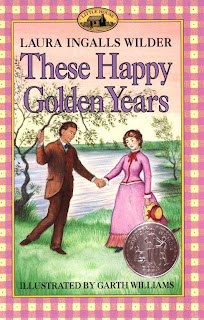
 Wilder, Laura Ingalls. 1943. These Happy Golden Years.
Wilder, Laura Ingalls. 1943. These Happy Golden Years.
Sunday afternoon was clear, and the snow-covered prairie sparked in the sunshine. A little wind blew gently from the south, but it was so cold that the sled runners squeaked as they slid on the hard-packed snow. The horses' hoofs made a dull sound, clop, clop, clop. Pa did not say anything.
These Happy Golden Years begins directly after the close of Little Town On the Prairie. Laura is fifteen--a few weeks shy of her sixteenth birthday. She has been hired to teach school for two months. The school where she is to teach is for a community around twelve miles away. Pa is taking her to the place where she'll be boarding. She expects to stay there for eight weeks all on her own--homesick or not; miserable or not. The Brewsters--the family she stays with--are miserable company. Mrs. Brewster is one angry, potentially psycho woman. (I never could quite figure out why she's threatening her husband with a knife.) School is awful. She doesn't really like teaching at all. But the thing that keeps her going--the thing that surprises her week after week after week--is that Almanzo comes to take her home and back each and every weekend no matter how cold. These trips are often silent, but much appreciated.
But when the eight weeks are over, Laura is surprised that his courting--his wooing--continues. Rides in his sleigh. Rides in his buggy. He's an almost constant present every week.
It isn't just rides and courting, however. Laura is back in school, back with her friends, back with her family. Seasons come and go. Other teaching opportunities arise--which she accepts--none are ever as horrid as the first.
Without a doubt, my favorite gleeful, giddy-making chapter is "Barnum Walks."
"I was wondering..." Almanzo paused. Then he picked up Laura's hand that shone white in the starlight, and his sun-browned hand closed gently over it. He had never done that before. "Your hand is so small" he said. Another pause. Then quickly, "I was wondering if you would like an engagement ring."
"That would depend on who offered it to me," Laura told him.
"If I should?" Almanzo asked.
"Then it would depend on the ring." Laura answered and drew her hand away.
The next week...well, I don't want to spoil it. But I love it.
"It will have to be a little house. Do you mind?"
"I have always lived in little houses. I like them." (214-215)
Anyway, it is a thoroughly enjoyable, perfect, perfect book.
289 pages
Wilder, Laura Ingalls. 1940. The Long Winter.
The mowing machine's whirring sounded cheerfully from the old buffalo wallow south of the claim shanty, where bluestem grass stood thick and tall and Pa was cutting it for hay.
This first chapter is called "Make Hay While the Sun Shines" and if it's found within a book called THE LONG WINTER, the reader knows what to expect even if the characters don't. The book opens with Ma and Pa and family getting ready for harvest and winter. Laura is helping out Pa. Mary and Carrie are helping out Ma. Laura is especially pleased that she's old enough (around 14 now) to help Pa and do outdoor chores.
The Ingalls family is living in their claim shanty. This would be the first fall/winter they've been there. And they know it will be tough, but when the first blizzard comes in October, they know that it wouldn't only be tough to survive but impossible to survive if they were to try to stay on their homestead. Fortunately, Pa owns property in town. A place where they can be nice and warm and cozy for the winter. Or so they think.
What no one could know is just how hard, how long, how tough this winter was going to be. Some folks are prepared--the Wilder boys for instance--but most are not. Most are relying on the train making regular stops in town. The trains are essential for stocking the stores of supplies. But when almost every day brings a blizzard--with clear days coming only one at a time and never on a predictable schedule--it soon becomes clear that the trains will not be saving the day. Not til spring. The town's survival, the Ingalls' family survival, is a big if at this point.
Cold. Hunger. Starvation. No supplies. What's not to love?
The Long Winter has always been one of my favorites of the Little House series. I'll admit it tends to make you cold and hungry. But that's not a bad thing, right? I didn't think so. Only two books can trick my mind and body--okay maybe three--into thinking it's cold and hungry. One, of course, is The Long Winter. The other two are by Susan Beth Pfeffer. I think one of the reasons I love The Long Winter is that it introduces Almanzo Wilder onto the scene. True, there was Farmer Boy if you didn't skip it like I have done. But this Almanzo is a man--a young man it's true--19 years of age. And he's acting "manly" alright when it's time to save the day. I love every scene Almanzo is in. Laura first meets him when she's lost and trying to find her Pa in the slough of hay. Here is the description: "His blue eyes twinkled down at her as if he had known her a long time." Anyway, I love this book.
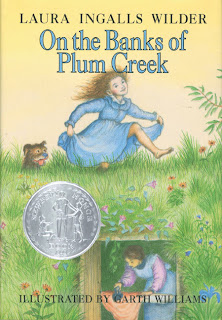
Wilder, Laura Ingalls. 1937. On the Banks of Plum Creek.

The dim wagon track went no farther on the prairie, and Pa stopped the horses. When the wagon wheels stopped turning, Jack dropped down in the shade between them. His belly sank on the grass and his front legs stretched out. His nose fitted in the furry hollow. All of him rested, except his ears.
On The Bank of Plum Creek opens when the Ingalls family arrives at their new home. They have bought a place, and their first new "home" is a dugout. They are buying it from a Norwegian man, Mr. Hanson, who is moving further west I presume. This is just temporary. Charles (or "Pa" as he's referred to so often it's hard not to join in) has promised to build them a real house, a real home just as soon as he can. The book opens with promises and hopes and dreams. But most of the book will see those hopes and dreams delayed. What Pa needs--what they all need--are good crops, good wheat crops. What Pa gets is grasshoppers. The Ingalls family does struggle a bit in On The Banks of Plum Creek. But they do settle in and get comfortable. Mary and Laura, for instance, start school. It is the first time for them to ever attend school. And they do meet up with some town folks like Nellie Oleson.
Overall, this is a more than enjoyable read. Some of my favorite chapters are "Nellie Oleson," "Town Party," "Country Party," "Going to Church," and "Surprise."
It is 339 pages.

Mull, Brandon. 2007. Fablehaven: The Rise of the Evening Star.

It has now been a year since Kendra and Seth have visited their grandfather and grandmother (whom we first met as a chicken) on their Fablehaven estate (or preserve to be a bit more accurate). Our narrative opens with Kendra anticipating the last week of school--her last week at a middle school. It's an unusual time for a school--a class--to receive a new student--with only one week to go--but only Kendra knows quite how strange it is. The new student? Not human. A monster. A monster with foul breath. When Kendra's unable to reach her grandfather, she decides to trust the man who claims to be sent at her grandfather's request. A man called Errol. Kendra and Seth thus end their school year with a bit of adventure and danger and mystery. Soon summer will be here. The summer may just hold another action-packed, adventure-filled, mystery-solving, danger-ridden, journey for the two as they visit their grandparents once more. Full of action, suspense, mystery, and adventure...this second book is even better than the first.
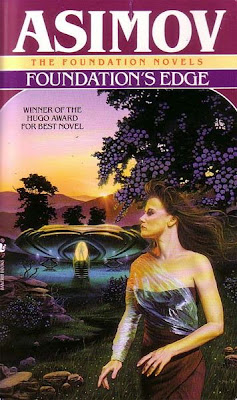
 Foundation's Edge
Foundation's Edge by Isaac Asimov was originally the fourth in the Foundation series. The third novel, Second Foundation, was published in 1953. (The two stories that the novel consists of were published in 1948 and 1949.) Foundation's Edge was published in 1982. Unlike the previous Foundation novels, the remaining books in the series--Foundation's Edge, Foundation and Earth, Prelude to Foundation, Forward the Foundation--were written AS novels. Does it make a difference? You bet! A great BIG difference as far as I'm concerned. Why? The novels seem sloppier, wordier, and sleep-inducing. Okay, maybe they won't really PUT you right to sleep. But in a word. Boring. No pizazz. No magic. Few WOW moments. And a whole lot of asides and tangents. Unless sociology, philosophy, science--all hypothetical studies of the three of course--lessons fascinate you and keep you turning pages, you'll find these novels lack the concise power of the original trilogy.
by Isaac Asimov was originally the fourth in the Foundation series. The third novel, Second Foundation, was published in 1953. (The two stories that the novel consists of were published in 1948 and 1949.) Foundation's Edge was published in 1982. Unlike the previous Foundation novels, the remaining books in the series--Foundation's Edge, Foundation and Earth, Prelude to Foundation, Forward the Foundation--were written AS novels. Does it make a difference? You bet! A great BIG difference as far as I'm concerned. Why? The novels seem sloppier, wordier, and sleep-inducing. Okay, maybe they won't really PUT you right to sleep. But in a word. Boring. No pizazz. No magic. Few WOW moments. And a whole lot of asides and tangents. Unless sociology, philosophy, science--all hypothetical studies of the three of course--lessons fascinate you and keep you turning pages, you'll find these novels lack the concise power of the original trilogy.
Foundation's Edge is the story of two men really. Golan Trevize and Janov Pelorat. Golan Trevize is a Councilman on Terminus. Janov Pelorat is a historian, a scholar, on Terminus. Trevize is exiled by the Mayor because he voiced doubts about the Seldon Plan. He voiced doubts about psychohistory. He voiced concern that the Second Foundation was still out there and still out to get them. Janov Pelorat is forced into exile as well. Not because he did anything wrong, but because Trevize is thought to need a companion, an excuse, a reason to make the journey. Pelorat's hopes and dreams revolve for a time around finding the OLDEST planet, the planet of origin, the place thought of as Earth. Trevize isn't concerned about Earth. He wants to try to find the Second Foundation--if it exists at all--and wants to destroy it. But the two are forced to live together, work together, travel together. They spend most of this book, and most of the next, together on a small spaceship. (A spaceship for 4.)
These characters aren't the only ones doing the narrating, however. There are plenty of minor roles. Plenty of plot twists. Some members of the Second Foundation contribute a large part to the story. But the heart of this one is the ongoing quest by Pelorat and Trevize. Trevize for one reason or another goes along with this search for Earth, and their search leads them somewhat indirectly to the planet Gaia. Oh how tired I am of hearing about Gaia.
Gaia is perhaps a nicer concept of the Borg. It is a planet of "we" and not "I." The air, the soil, the plants, the animals, the humans, the excrements, the food, the walls, the beds, the clothes, everything IS Gaia. Bliss, the woman they meet, is Gaia. She is a part of the planet. Everything she sees, everything she hears, everything she knows, is part of Gaia. There is just one collective memory, one collective consciousness.
Gaia--Bliss--has been drawing--manipulating--Trevize and Pelorat to the planet. And they're not the only ones. Gaia wants to have a big SHOWDOWN with the Second Foundation, the First Foundation, and Gaia. They want Trevize to decide the fate of the universe. Which of the three--Foundation, Second Foundation, Gaia--he wants to see rule the universe for the rest of eternity. Talk about pressure.
S
P
O
I
L
E
R
For some reason or other--he chooses Gaia's concept of Galaxia. A concept that will turn the entire universe--the entire galaxy--into a super-organism. Every part of the universe--the planet, the air, the humans, the animals, the bacteria, the plants, the curtains, etc. into one collective consciousness. It is the loss of individualism. Every person, every animal, every insect, every blade of grass, every amoeba will be Galaxia. He's told that it will be a time-consuming process that will take several hundred years--probably five or six hundred years. So he chooses it with the thought that he can always unchoose it. But is that really true?

 Foundation and Earth
Foundation and Earth picks up right where Foundation's Edge ended. Essentially. But there is some inconsistency between Foundation's Edge and Second Foundation. I don't know how many readers notice this or how many readers care. I don't know if Asimov did this intentionally. But early in Foundation's Edge, one of the main characters, Janov Pelorat, is forced by the Mayor of Terminus into exile alongside Golan Trevize. They make a point of mentioning that Pelorat is leaving behind his wife. Not only is she just his wife--she's his pregnant wife. They refer to her only a handful of times, but apparently, by the end of the novel Pelorat has completely forgotten about his wife. Completely. Forgotten he was married. Forgotten that he was going to be a father. In the last chapter or so, he takes up with a new woman of sorts, Bliss, and for the rest of Foundation's Edge and all of Foundation and Earth not another word is spoken about Pelorat's poor, pregnant, abandoned wife back on Terminus. I believe at one point Bliss even asks if Pelorat is married and he says that he hasn't been married for years. A blatant lie on his part OR a forgetful Asimov at work.
picks up right where Foundation's Edge ended. Essentially. But there is some inconsistency between Foundation's Edge and Second Foundation. I don't know how many readers notice this or how many readers care. I don't know if Asimov did this intentionally. But early in Foundation's Edge, one of the main characters, Janov Pelorat, is forced by the Mayor of Terminus into exile alongside Golan Trevize. They make a point of mentioning that Pelorat is leaving behind his wife. Not only is she just his wife--she's his pregnant wife. They refer to her only a handful of times, but apparently, by the end of the novel Pelorat has completely forgotten about his wife. Completely. Forgotten he was married. Forgotten that he was going to be a father. In the last chapter or so, he takes up with a new woman of sorts, Bliss, and for the rest of Foundation's Edge and all of Foundation and Earth not another word is spoken about Pelorat's poor, pregnant, abandoned wife back on Terminus. I believe at one point Bliss even asks if Pelorat is married and he says that he hasn't been married for years. A blatant lie on his part OR a forgetful Asimov at work.
Foundation and Earth is the story of Pelorat, Bliss, and Trevize. These three are out exploring the galaxy doing everything in their power to find Earth. Trevize is convinced that Earth holds all the answers, all the secrets of the universe. It's a quest he's willing to risk his life--and the lives of his friends--time after time after time. They visit a handful of planets. Each one scarier--either physically or psychologically--than the one that came before. Some are truly horrifying places. And of course at the MOST horrifying one of all they pick up a passenger. Travize doesn't want to. He fights it then and almost every chapter after that. But it does no good. No one will listen to him. The passenger is a young child. A child that they were told would be killed. But by saving this child, did they doom the universe?
I'm not going to have any more spoilers. These four and their quest to find Earth....and what they found and what they did....well, you'll just have to read for yourself.
These two had their brief moments of glory where the writing was good and the plot twists intriguing. However, for the most part, they lacked a lot in storytelling power. I think Asimov's problem with these novels is that sometime between 1953 and 1982, he decided, he determined that the world of Foundation had to be combined with the world he created in his Robot series. I haven't read the Robot series myself. But if these latter novels are any indication, I don't know that I want too. Perhaps, the earlier Robot novels are good. Perhaps not. Maybe fans of the Robot series were let down by these latter books too. Maybe they wish Foundation and Robots had not been combined. Who knows. I only know that Foundation's Edge and Foundation and Earth had way too many awkward conversations about humans and robots having sexual relationships.
Here is how the series is supposedly supposed to go these days.
The Complete Robot (collection of short stories)
The Caves of Steel (1954)
The Naked Sun (1957)
The Robots of Dawn (1983)
Robots and Empire (1985)
The Stars, Like Dust (1951)
The Currents of Space (1952)
Pebble in the Sky (1950)
Prelude to Foundation (1988)
Forward the Foundation (1993)
Foundation (1951)
Foundation and Empire (1952)
Second Foundation (1953)
Foundation's Edge (1982)
Foundation and Earth (1986)
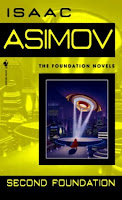
So I finished the third book in the original Foundation trilogy. (The other two being Foundation and Foundation and Empire.) Of the three, I must admit a strong preference for the middle novel. There is something magical that just works about Foundation and Empire. But that's not to say that Foundation and Second Foundation weren't enjoyable enough reads.
What can I say about Second Foundation? Well, it was originally published in novel form in 1953. It had previously been published as two separate short stories in 1948 and 1949. If memory serves me, around four hundred years have elapsed since the opening of Foundation. (It *might* be three hundred or five hundred. But my gut is saying four.) The stories share a theme--a strong theme. While all of the novels--the stories--have shared the theme of preservation and ambition, Second Foundation expands on that theme. This novel is all about the quest.
In the first story, those doing the questing are The Mule and the Mule's men. Han Pritcher, a character first introduced in Foundation and Empire, is one of the main characters. Bail Channis is a new character. He plays a rather large role in the story. These two have been paired together by The Mule to go on a quest--a search--for the Second Foundation. Their goal? To find out where it is so The Mule can finish his conquest of the Galaxy and rule supreme over all. Ambitious? Definitely! Doomed to fail? Probably. But the two have been given the mission without the option of saying no.
In the second story, those doing the questing are the descendants of Bayta and Toran Darell. Their son, Toran, and granddaughter, Arcadia, unknowingly hold the fate of the Second Foundation in their hands. Arcadia (or Arkady as she likes to be called) is only a teen--14 to be exact--but she is determined to have her chance for glory--her chance to be a hero. Her idol? Her grandmother who helped take down The Mule. Arcadia's quest? To be the one to find the Second Foundation. Her goal to help the Foundation destroy the Second Foundation. She's definitely an original, spunky kind of heroine. Very opinionated. Very determined. But can it be down? Can one person single-handedly do the seemingly impossible?
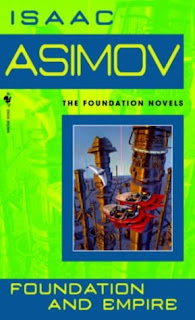
Foundation and Empire by Isaac Asimov was originally the second in a trilogy of novels. First published in 1952, the novel is in fact two stories or two novellas originally published (separately) in 1945.
Things you should know:
*Foundation was good. Really good. But Foundation and Empire was even better.
*Foundation and Empire is infinitely better than Prelude to Foundation.
*While I would certainly recommend reading Foundation, I think you could pick up Foundation and Empire without having read the other and still appreciate it for the great book that it is. It does in fact include a nice two page summary of the novel Foundation.
*Foundation and Empire has a certain something-special about it that makes it stand apart from Foundation. The writing seems wittier, funnier, more tongue-in-cheek. There's just something about it that makes it pop.
I am still operating under the philosophy of sometimes it is better not to know, BUT at the same time I don't want to be accused of not "reviewing" it properly.
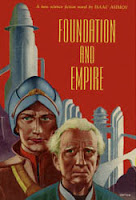 Foundation and Empire roughly picks up about three hundred years after Foundation opens. In the first novella, "The General" the reader learns of the fourth (I believe it's fourth) Seldon crisis. One of the strongest generals of the Empire (what remains of the Empire) is out to destroy the Foundation. Bel Riose is the general's name. Ducem Barr, the son of a man we met briefly in Foundation, is a main character--a character that opposes the Empire even at great risk to his own life and his own family. Lathan Devers, a trader, is also of importance. The plot of "The General" is relatively simple, and this is the shorter of the two stories. In the second novella, "The Mule" the Foundation faces its GREATEST threat so far. It begins simply with the homecoming of a bride and groom. Bayta and Toran. They're visiting Toran's family on the planet of Haven. Haven is a "rat hole" of a planet where traders--mostly retired traders--go to hide out and evade paying taxes to the Foundation. The planet is technically a part of the Foundation. But they're more of a rebellious bunch on Haven. The reader soon learns that not everyone thinks Foundation is perfect when it comes to running the galaxy--or their small part of the galaxy. There is discontent among the ranks of citizens. But even the threat--the small threat--of civil war pales in comparison to the REAL threat of The Mule. I will say no more about the Mule or the rest of the story. I don't care how curious you are! Some things you can't pry out of me.
Foundation and Empire roughly picks up about three hundred years after Foundation opens. In the first novella, "The General" the reader learns of the fourth (I believe it's fourth) Seldon crisis. One of the strongest generals of the Empire (what remains of the Empire) is out to destroy the Foundation. Bel Riose is the general's name. Ducem Barr, the son of a man we met briefly in Foundation, is a main character--a character that opposes the Empire even at great risk to his own life and his own family. Lathan Devers, a trader, is also of importance. The plot of "The General" is relatively simple, and this is the shorter of the two stories. In the second novella, "The Mule" the Foundation faces its GREATEST threat so far. It begins simply with the homecoming of a bride and groom. Bayta and Toran. They're visiting Toran's family on the planet of Haven. Haven is a "rat hole" of a planet where traders--mostly retired traders--go to hide out and evade paying taxes to the Foundation. The planet is technically a part of the Foundation. But they're more of a rebellious bunch on Haven. The reader soon learns that not everyone thinks Foundation is perfect when it comes to running the galaxy--or their small part of the galaxy. There is discontent among the ranks of citizens. But even the threat--the small threat--of civil war pales in comparison to the REAL threat of The Mule. I will say no more about the Mule or the rest of the story. I don't care how curious you are! Some things you can't pry out of me.
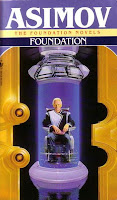
Some books feel like friends from the very beginning. Such is the case with Isaac Asimov's novel, Foundation. This book was originally the first in a series of Foundation novels. (However, Prelude to Foundation has since been published.) The novel is composed of five sections. Four of these sections were originally published separately and appeared as short stories in Astounding Magazine between 1942 and 1944. They were later compiled together into one volume in 1951 alongside a newly written introduction section, and thus Foundation as we know now it was published. (Does any of that matter? Not really. I didn't read the details on the publishing history until after I read it. But as an after note, I was intrigued by it. So I thought I'd share it with you.)
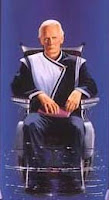 For twelve thousand years the Galactic Empire had ruled supreme. Now it was dying. But only Hari Seldon, creator of the revolutionary science of psychohistory, could see into the future--a dark age of ignorance, barbarism, and warfare that would last thirty thousand years. To preserve knowledge and save mankind, Seldon gathered the best minds in the Empire--both scientists and scholars--and brought them to a bleak planet at the edge of the Galaxy to serve as a beacon of hope for future generations. He called his sanctuary the Foundation.
For twelve thousand years the Galactic Empire had ruled supreme. Now it was dying. But only Hari Seldon, creator of the revolutionary science of psychohistory, could see into the future--a dark age of ignorance, barbarism, and warfare that would last thirty thousand years. To preserve knowledge and save mankind, Seldon gathered the best minds in the Empire--both scientists and scholars--and brought them to a bleak planet at the edge of the Galaxy to serve as a beacon of hope for future generations. He called his sanctuary the Foundation.
But soon the fledgling Foundation found itself at the mercy of corrupt warlords rising in the wake of the receding Empire. Mankind's last best hope was faced with an agonizing choice: Submit to the barbarians and be overrun--or fight them and be destroyed.
What can I say about Foundation without giving too much away? It is one of those rare books where it's best not to know. Best not to have preconceived notions of what it's all about. Best not to think too much about what it's saying and where it's going. It's best to just go along for the ride on this one.
The settings? Various planets. The characters? Too many to list. The plot? Complex but not difficult to follow. Each section of the book is separate from the whole. Most are divided by time. Between sections, thirty years, eighty years, fifty years, a hundred years could have passed. The reader picks up hints here and there about how much time has gone by. But this isn't a book where you follow characters around. This is more of a novel where ideas play the leading role.
If there is a cohesive theme to the novel it is manipulation. Whether passive or aggressive, Foundation is all about power struggles, manipulations, and getting others to do what you want when you want. It is all about ambition.
Do not look at this chart unless you want to confuse yourself. (Or you've read a good many of the books already.) For plot summary of the first novel, click here. For more information on the series as a whole, click here.

By:
Becky Laney,
on 1/10/2008
Blog:
Becky's Book Reviews
(
Login to Add to MyJacketFlap)
JacketFlap tags:
TBR Reading Challenge,
YA Fantasy,
YA Romance,
Young Adult Challenge,
Speculative Fiction Challenge,
Winter Reading Challenge,
A ~ Z Reading Challenge,
2007,
series challenge,
Chunkster Challenge,
Add a tag
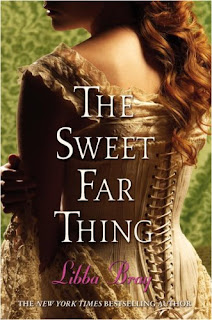
Bray, Libba. 2007. The Sweet Far Thing.
The Sweet Far Thing concludes the trilogy following Gemma Doyle and her quests in and out of the realms. (The first being A Great and Terrible Beauty which I read at least six months or so before I started blogging so there's no record of what I thought. And the second being Rebel Angels which I reviewed last winter/spring.) The book is heavy both in content and weight. 819 pages. Most of them of seventeen-year-old Gemma confused about who she is and what she wants. At the end of Rebel Angels, Gemma bound the magic of the realms to herself. She had promised several different peoples or tribes that she would later share the magic and make peace throughout the realms; she would issue in a new era of peace and unity. The close of Rebel Angels also saw the death of Circe. (or did it???)
The Sweet Far Thing picks up three months later. It is spring. Felicity and Gemma are getting ready to make their debut in society. And Ann, poor Ann, is still going to be a governess. She's still being treated horribly by the other girls at Spence Academy. Mrs. Nightwing is planning a big masked ball in honor of the graduating class--the class of which Gemma and Felicity and Ann are a part. The other buzz around campus is the ongoing work to complete the East Wing. Mrs. Nightwing is determined that the East Wing which was originally destroyed by fire twenty-five years before, needs to be rebuilt in order for Spence to regain its honor and prestige. But there are many people who fear what will happen when the East Wing is rebuilt. They're afraid of what might become unsealed and unburied. The Gypsies. Mother Elena especially is full of warnings. Most of which go unheeded. But such is the way with those that prophesy foreshadowing.
Getting back to Gemma. Gemma was having an identity crisis of sorts in Rebel Angels. She feared that no one really loved her for her. That her father and grandmother and brother all have their own "idea" of who she is. An idea that is far from reality. And she's worried that her friends just love her, just include her because of her magic, because of her power. She was tempted for a while by a boy, Simon, but then felt he didn't love her for her, know her for her either.
This quote is from Rebel Angels:
To Felicity and Ann, I’m a means into the realms.
To Grandmama, I am something to be molded into shape.
To Tom, I am a sister to be endured.
To Father, I am a good girl, always one step away from disappointing him.
To Simon, I’m a mystery.
To Kartik, I am a task he must master.
My refelection stares back at me, waiting for an introduction. Hello, girl in the mirror. You are Gemma Doyle. And I’ve no idea who you really are. (396-397)
Back to Sweet Far Thing. So Gemma is still learning who she is, what she wants, what she needs, and even learning what she fears most. When the book opens, the reader learns that Gemma has not been able to regain access to the realms. She can no longer conjure up the white door. She has seemingly lost her power. Also of note, the dreams and visions have stopped for the most part. But with 819 pages, the reader knows this powerlessness won't last long. Gemma will find a way; she always finds a way to get what she wants or what she thinks she wants.
There is mystery, confusion, epic battles between good and evil, trickery, betrayal, secrets, lies, love and lost love, fear and hope. There is family drama and school drama. And drama between friends as boundaries are pushed or nudged and little lies are told. Fans of the series will no doubt be anxious to read this saga through to its bittersweet conclusion. (I read it in two days.) But I'm unable to predict how they'll feel about the ending. I know my response. (Though I won't go there here in this post.) But how will fans react?
I haven't mentioned lately that I have joined the Series Challenge. I remember talking about it in August or maybe September. But not lately. So it has just begun. I think it started December 1. I saw that it had started. And I began each day thinking that I'd type something up. But well, you see how far that got me. So what books am I going to be reading?
Well, I know the Lord of the Rings/Hobbit stuff by Tolkien. I know the Chronicles of Narnia by C.S. Lewis. I'm hoping for all of the Little House books by Laura Ingalls Wilder. All the Anne books by L.M. Montgomery. All the Ramona books by Beverly Cleary.
That's more than enough books to choose from in my reading. I don't think I can get to all of them before the challenge is up, but I'll probably get to some of them anyway. :)
December 1, 2007 through May 31, 2008
 Seeing Emily by Joyce Lee Wong is an unusual young adult book because it is written entirely in verse. Following the life of Emily Wu, a sixteen year old Chinese American living in Richmond, Virginia, the book is set out in poetic episodes of first person narrative. It begins in the Chinese restaurant of Emily’s parents where she helps out part-time. The first section titled “Golden Palace” begins with a poem called “Flirting.” It is clear from this opening that Emily is embarking on a journey of adolescent awakening. However, it is not just a sexual awakening that Emily experiences but also an awakening to her identity as an Asian American woman. Typically, feelings of shame — towards her parents’ eating habits, for example — mingle with her protective affection for them. Similarly, her feelings of ambivalence towards a talented Chinese school mate, Alex Huang, are in direct opposition to the near adulation of her first boyfriend, Nick, who, she realizes later, cannot see beyond her Asian features to the girl inside.
Seeing Emily by Joyce Lee Wong is an unusual young adult book because it is written entirely in verse. Following the life of Emily Wu, a sixteen year old Chinese American living in Richmond, Virginia, the book is set out in poetic episodes of first person narrative. It begins in the Chinese restaurant of Emily’s parents where she helps out part-time. The first section titled “Golden Palace” begins with a poem called “Flirting.” It is clear from this opening that Emily is embarking on a journey of adolescent awakening. However, it is not just a sexual awakening that Emily experiences but also an awakening to her identity as an Asian American woman. Typically, feelings of shame — towards her parents’ eating habits, for example — mingle with her protective affection for them. Similarly, her feelings of ambivalence towards a talented Chinese school mate, Alex Huang, are in direct opposition to the near adulation of her first boyfriend, Nick, who, she realizes later, cannot see beyond her Asian features to the girl inside.




















I can't wait to read this!!
I had the chance to have dinner with Brandon Mull last Wednesday. He says he thinks the Fablehaven books get better as they go. Can't wait to read this one... and only 1 year until the next!
Yeah this one was great!! I should have my review of it up on Friday...at least that's my aim!
Great review. And a killer cover. Brandon said recently that when he saw the cover art, his inner ten year-old was jumping around shouting "Yes! Yes!" Which was actually kind of a fun thing to see him act out.
I just got an invitation to the launch party for this book in SLC. I may have to make arrangements to go. The illustrator will be there as well. I agree, this book cover is fantastic.
I don't want to be misleading. It's pretty much a form invitation to an open party but sounds like fun.
For a coursework for image processing and reconstruction using momentsmicrofiche scanning with legendre and maximum entropy methods. rqpdnqz